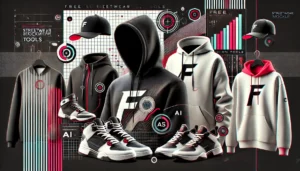Introduction to Online Fashion Retail and Personalization
The rise of online fashion retail has drastically transformed how we shop for clothes. At the heart of this transformation is personalization—an approach where fashion retailers tailor shopping experiences to individual customers based on their preferences, behaviors, and needs. By offering personalized recommendations, targeted marketing, and tailored content, online fashion retailers are enhancing the shopping experience while boosting sales and customer loyalty. This article will explore how personalization is reshaping online fashion and the technologies driving this shift.
The Growth of Online Fashion Retail
How E-commerce is Reshaping the Fashion Industry
Over the past decade, the fashion industry has seen a significant shift from brick-and-mortar stores to online platforms. E-commerce has expanded the reach of fashion brands, making it easier for consumers to access global markets with a few clicks. The convenience of shopping online, combined with advances in delivery and return services, has made online fashion retail a dominant force in the industry.
The Shift from Physical Stores to Online Shopping
While physical stores offer the advantage of in-person experiences, many consumers now prefer the ease and flexibility of shopping online. The ability to browse, compare prices, and shop from the comfort of home, along with personalized recommendations, has made online fashion retail platforms highly popular. This shift has prompted brands to invest in personalization technologies to stay competitive and offer customers more tailored shopping experiences.
What is Personalization in Online Fashion Retail?
Defining Personalization in E-commerce
Personalization in online fashion refers to tailoring the shopping experience to individual customers based on their preferences, behaviors, and interactions with the brand. This can include recommending products based on earlier purchases, customizing emails with special offers, or even designing the homepage to match a customer’s style.
The Role of Data in Personalization
Data is the foundation of personalization. By analyzing customer behavior, browsing patterns, and buy history, fashion retailers can offer relevant and timely recommendations. With the help of big data, brands can create highly personalized experiences that feel unique to each shopper, increasing customer satisfaction and retention.
The Benefits of Personalization in Online Fashion
Enhancing Customer Experience Through Tailored Suggestions
One of the primary benefits of personalization is the enhanced customer experience it provides. When shoppers receive tailored product recommendations that match their style and preferences, they are more likely to make a purchase. Personalized shopping experiences create a sense of connection between the customer and the brand, making them feel understood and valued.
Increasing Conversion Rates and Reducing Cart Abandonment
Personalization can also significantly affect a brand’s bottom line by increasing conversion rates and reducing cart abandonment. By offering personalized recommendations and reminders, brands can guide customers through the purchasing process, ensuring they find what they are looking for and encouraging them to complete their purchases.
Building Long-Term Customer Loyalty
Personalization goes beyond immediate sales; it helps build long-term customer loyalty. When customers feel that a brand understands their preferences and delivers relevant content, they are more likely to return for future purchases. This loyalty results in higher customer lifetime value (CLTV) and increases brand advocacy.
How Personalization Works in Online Fashion
AI-Driven Product Recommendations
At the core of personalization in online fashion is artificial intelligence (AI). AI-powered algorithms analyze customer data, such as browsing history and past purchases, to generate personalized product recommendations. These recommendations appear in product listings, emails, and even during the checkout process, helping customers find exactly what they need.
Personalized Emails and Marketing Campaigns
Fashion retailers also use personalization to create targeted email campaigns. These emails often include product recommendations, special offers, or reminders based on the customer’s recent activity. Personalized emails have higher open and click-through rates, increasing the likelihood of a successful sale.
The Role of Technology in Personalization
Machine Learning and AI Algorithms in Fashion
Machine learning and AI algorithms are the driving forces behind personalized experiences in online fashion retail. These technologies enable fashion brands to learn from customer data and deliver recommendations that evolve with changing preferences. Over time, the more data AI systems collect, the better and more accurate the personalization becomes.
Leveraging Big Data for Personalization
Big data plays an important role in enabling brands to personalize the shopping journey. By collecting and analyzing massive amounts of data—from social media activity to buy history—brands can create hyper-personalized experiences that meet the specific needs of each customer.
Major Brands Using Personalization to Drive Sales
How Amazon, ASOS, and Zalando Personalize the Shopping Experience
Leading e-commerce platforms like Amazon, ASOS, and Zalando have embraced personalization to enhance their customer experience. Amazon’s recommendation engine, for example, uses AI to suggest products based on customer history. Similarly, ASOS and Zalando offer curated shopping experiences, where customers receive tailored fashion suggestions that reflect their preferences.
Case Studies of Luxury Brands Implementing Personalization
Luxury fashion brands are also investing in personalization strategies to maintain exclusivity while offering tailored experiences. Brands like Burberry and Gucci use AI-driven recommendations and targeted marketing to deliver personalized shopping experiences that align with the luxury market’s high expectations.
Personalization in Fashion E-commerce Platforms
Customizing the Homepage Based on User Preferences
Many fashion e-commerce platforms are now customizing the homepage experience based on user behavior. For example, a returning shopper might see product recommendations based on their previous purchases, while a new user might see trending items or best-sellers. This dynamic customization helps brands capture customer attention immediately.
Tailoring the Shopping Journey with Behavioral Data
Behavioral data, such as the time spent on certain pages or items added to the cart, helps brands tailor the shopping journey. For example, if a customer often views a particular category, the platform might prioritize similar products in future visits, making it easier for the shopper to find what they want.
The Impact of Personalization on Customer Experience
Creating Seamless Shopping Experiences
Personalization makes the shopping experience seamless by anticipating customer needs. Whether through product recommendations, customized content, or tailored discounts, customers enjoy a frictionless journey from browsing to checkout, enhancing their overall satisfaction.
Real-Time Personalization to Keep Customers Engaged
Real-time personalization, driven by AI, keeps customers engaged throughout their shopping experience. Brands can dynamically adjust content, offers, and recommendations in real-time, based on customer behavior, making sure the shopping experience feels timely and relevant.
Personalization in Fashion Marketing
Personalized Ads and Social Media Campaigns
Social media platforms, such as Instagram and Facebook, let fashion brands create highly personalized ads. These ads are tailored to specific customer segments, making sure users see content that aligns with their preferences. By using AI-driven ad targeting, brands can increase engagement and drive more traffic to their online stores.
Retargeting Customers with Tailored Offers
Retargeting is another personalization strategy used in fashion marketing. If a customer leaves a site without completing a purchase, brands can retarget them with personalized offers or reminders about items left in the cart. This approach helps convert abandoned carts into sales and keeps the brand top of mind.
The Challenges of Implementing Personalization in Online Fashion Retail
Data Privacy Concerns and Customer Trust
While personalization offers many benefits, it also raises data privacy concerns. Customers are learning of how their data is being used, and brands must ensure transparency to maintain trust. Striking the right balance between personalization and privacy is essential for long-term success.
Balancing Automation with Human Touch
While AI and automation are key to scaling personalization, maintaining a human touch is crucial in fashion. Customers still value personal interaction, especially with luxury brands, where service is a major differentiator. Brands must balance automated personalization with the warmth of human engagement.
The Future of Personalization in Online Fashion Retail
Hyper-Personalization: Going Beyond Just Recommendations
The future of online fashion will involve hyper-personalization, where brands go beyond simple recommendations. AI will enable brands to offer fully customized shopping experiences, from bespoke designs to real-time wardrobe updates, creating a more intimate and tailored experience for each shopper.
How Personalization Will Shape the Future of Online Retail
As technology continues to evolve, personalization will become even more integrated into the fabric of fashion retail. From smart mirrors in physical stores to virtual stylists online, the retail landscape is set to become more interactive, responsive, and tailored to individual needs, reshaping the way consumers shop for fashion.
Conclusion
Personalization is revolutionizing the online fashion industry by offering customers a more tailored and engaging shopping experience. From AI-driven recommendations to customized marketing campaigns, brands are leveraging technology to build deeper connections with their customers and boost sales. As personalization technologies continue to evolve, they will play an even greater role in shaping the future of fashion, offering brands new ways to connect with their audience and provide a seamless, enjoyable shopping experience.
FAQs
How does personalization in online fashion work?
Personalization in online fashion uses AI algorithms and data analytics to tailor product recommendations, marketing content, and shopping experiences to individual customer preferences and behaviors.
What are the benefits of personalization for fashion brands?
Personalization helps fashion brands increase conversion rates, reduce cart abandonment, build customer loyalty, and provide a more enjoyable shopping experience that keeps customers coming back.
How does personalization impact customer loyalty?
Personalization makes customers feel understood and valued, leading to stronger brand loyalty. When shoppers receive tailored experiences, they are more likely to return for future purchases and recommend the brand to others.
What technologies drive personalization in online fashion?
Technologies like artificial intelligence (AI), machine learning, and big data analytics drive personalization in online fashion. These tools let brands analyze customer behavior and deliver relevant content in real-time.
What is the future of personalization in online fashion?
The future of personalization in online fashion will involve hyper-personalization, where brands offer fully customized shopping experiences based on real-time data. This will create even deeper connections between brands and consumers, reshaping the fashion industry.

